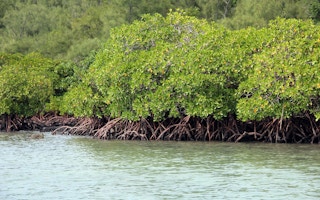Mangroves are carbon warriors. These salt-tolerant forests of trees and shrubs are known to lock away far greater amounts of atmospheric carbon dioxide than any other terrestrial forests, forming some of the most carbon-rich ecosystems on Earth.
But not all mangroves store carbon the same way. A new study has found that where a mangrove forest grows determines how much carbon it socks away.
While mangroves generally occur at the interface of land, sea and rivers, the coastal environments in which they grow—that is, how the rivers, tides, waves and climate have shaped the coastal landforms—can vary widely. Some mangrove forests are located in landscapes that are flooded by both river water and tides, for example. Some occur on open coasts experiencing both tides and waves from the sea. Others grow over limestone coral reefs or other carbonate landforms—environments that receive little fresh water.
These settings influence a number of processes, from the amount of nutrients that gets deposited in the soil to how much organic matter gets decomposed, among other things.
“
If you damage a mangrove forest with a large carbon stock, you may change the carbon flux from a sink to a source of carbon to the atmosphere. That is why mangrove conservation and restoration are so important.
Robert Twilley, professor, Louisiana State University
Now, for the first time ever, a team of researchers has taken into account these differences to estimate mangrove forests’ storage of so-called blue carbon in their soil. Blue carbon is the carbon that’s stored in the ocean or coastal ecosystems, including mangroves.
“While past estimates of blue carbon have done a remarkable job in delivering first order estimates of how ecosystems mitigate carbon enrichment in the atmosphere, we noted that the omission of unique coastal characteristics, such as tides and river flow, reduced the accuracy of global predictions, especially concerning how carbon storages may vary from one country to the next,” lead author Robert Twilley, a professor at Louisiana State University and the executive director of the Louisiana Sea Grant College Program, said in a statement.
To arrive at the estimates, Twilley and colleagues overlaid a high-resolution map of the world’s mangrove forest cover over the various types of coastal environments in which mangrove forests occur. They found that coastal settings matter a lot.
Previous studies have attempted to estimate how much blue carbon mangroves store across the world. But this new study found that past research has underestimated blue carbon stored in mangroves growing on carbonate soils, such as those in southwestern Florida and many Caribbean islands, by up to 50 per cent. In contrast, previous studies seemed to have overestimated blue carbon stored in deltaic settings, such as the delta mangroves of Nigeria, by up to 86 per cent.
“I was surprised by how closely carbon density in mangroves soils tracked the diverse coastal morphologies,” Twilley told Mongabay. “We had the idea and even published on the concept nearly 20 years ago. But to see all the data collected during that time by scientists around the world to actually fit into the conceptual framework was quite a pleasant surprise.”
The differences in carbon density between the various mangrove ecosystems come down to the soil in which they grow.
“Deltas are dominated by mineral sediment deposition and the trees invest most of the carbon in the aboveground structures—this is why they are some of the most spectacular forests in the world,” Twilley said. “But they have less carbon density in soil.”
Mangroves that grow in carbonate soils, by contrast, invest large amounts of carbon structure into roots, he added, to forage for as much phosphorus as possible to satisfy the nutritional requirements of the plants.
“Thus, mangroves in these soils have very high root productivity and thus very high soil organic carbon density,” Twilley said. “So the coastal morphology establishes the sediment and nutrient conditions of the environment, and plants respond with different contributions of mineral versus biological production to how soils are formed in mangrove forests.”
There’s a catch, though. In deltas, the amount of soil that gets added per year is far greater than the amount of soil that gets added to limestone landforms annually. So while delta soils have lower carbon density, the deep soils that get formed there over the years means that more carbon accumulates in the thick layers of soil annually compared to the thin layers of carbonate soils, such as those growing on top of limestone reefs, Twilley said.
Dan Friess, an associate professor and head of the mangrove lab at the National University of Singapore, who was not involved in the study, said the approach used in the study seemed robust.
“It is one of the only studies that has mapped coastal settings across the entire range where mangroves grow,” Friess said. “What is great about these findings is their scale; this is the best study so far in quantifying the effect of coastal setting on blue carbon across the entire tropics and sub-tropics. What was surprising about this study is just how large the differences are between coastal settings at this scale.”
Twilley’s study also provides new estimates of blue carbon for about 57 countries that previously lacked data on mangrove soil carbon.
Understanding how much carbon is stored in a mangrove forest—within the trees, the canopy of the forests, in roots and in the total depth of the soil—is essential in figuring out the amount of carbon that will be released into the atmosphere if the forest is destroyed.
“If you damage a mangrove forest with a large carbon stock, you may change the carbon flux from a sink to a source of carbon to the atmosphere. That is why mangrove conservation and restoration are so important,” Twilley said.
This story was published with permission from Mongabay.com










